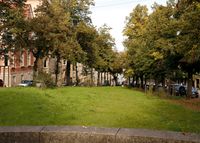City Climate and Health
There are many aspects to the term urban climate. A particular climate develops in large cities, which is influenced by all the buildings. However, the change in the natural composition of the air due to pollutants also describes the urban climate. As a result of climate change, cities have to prepare for increasingly hot summers. In 2019, a study calculated that, even in an optimistic climate scenario, the climate in Berlin in 2050 could be similar to today's climate in the Republic of San Marino - which is located on the Italian peninsula! In future, such heatwaves will become increasingly likely and more severe. It will become very hot in the densely built-up and asphalted city centre districts. That is already extremely stressful, especially for older and sick people. And this does not only affect cardiovascular diseases. Combined with other environmental stresses, excessive heat, air pollution and noise from traffic can be important factors that also affect mental health.
Heslach has an advantage over Stuttgart city centre and other districts due to its low building density and proximity to woodland. For example, there is an opening to the Neckar valley in the course of the Nesenbach in the north-east. To the south-west, the Nesenbach runs in a narrow valley. The shadowing effect of the surrounding mountain ranges means that local wind systems can develop, especially on the slopes and in the valleys, which do not cause high wind speeds but play an important role in the local ventilation of the city districts. This mountain wind system can be observed particularly well on hot and humid days in midsummer. The air exchange through cooler fresh air from the direction of Kaltental is particularly noticeable in Heslach.
In order to make our immediate living environment in Stuttgart tolerable for climate change, the following should be implemented at municipal level:
- increase green spaces and trees in public areas
- increased greening of building facades
- extending cycle lanes and footpaths
- reducing car traffic and car parks
- no more sealing and asphalting of green spaces
- no building on fresh air corridors
- creating and maintaining near-natural gardens
- as many public drinking fountains as possible
- use of churches as places to cool off and provide shade in midsummer





